Now that the Exclusions Reasons have been configured, you can proceed with screening underlying studies to identify those that should be Advanced and/or Included for your nest, or Excluded (for one of your configured Exclusion Reasons).
Note: If you are using Two-Pass Screening or Dual Screening, this process will differ slightly from the Standard workflow outlined below but the general workflow is the same. See the Two-Pass Screening, Dual Screening, Dual Two-Pass Screening pages for more details!
Steps for Standard Screening: #
1. Navigate to Screening #
You can either Screen Sequentially (by selecting “Screening” in the menu, outlined in red below), where records will be shown to you in order of expected Inclusion Probability, or screen from Inspector (outlined in black).

2. Read study abstract #
Your task in screening should be to identify, based on the Abstract content, whether the record falls under any Exclusion Reason, or whether it is on-topic for your review and satisfies your criteria for inclusion.
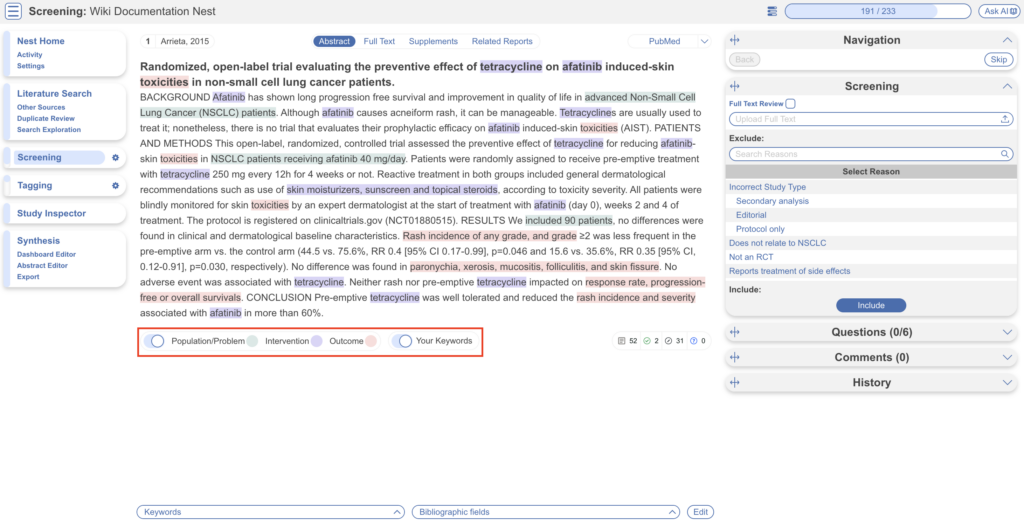
The Screening page displays an abstract highlighted with RoboPICO, which is an open source fork of the models offered in RobotReviewer that identifies the Population, Interventions, and Outcomes in an abstract. If too distracting you may toggle off the highlighting (red left); if you have configured your own keywords, you may also toggle these off (red right) by selecting “Your Keywords”.
Publication Details & Layout #
Accessing Record Documentation/Links #
Above the abstract, you can toggle between Abstract, Full Text, Supplements, and Related Reports to upload and access associated documentation (red) and access the external linkout via various links (blue).
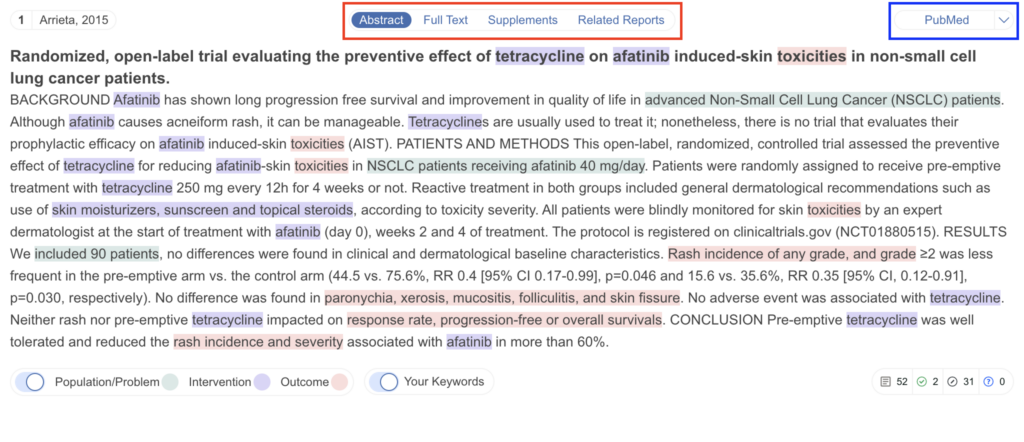
Using the scite banner #
Below the abstract, you can see the scite banner, which displays the number of times the publication in question was cited, supported, mentioned, and contrasted. If you click the banner, you can see more citation-related information provided by scite.ai, including retractions!
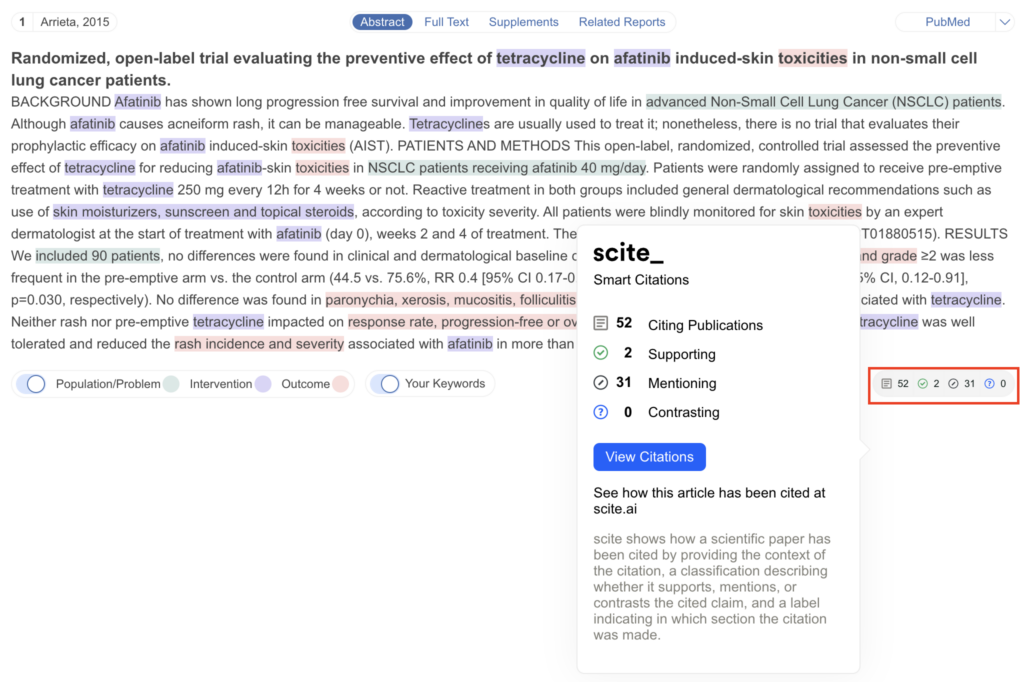
View or Edit Reference Data #
In the top left, the Ref ID, First Author, and Year is given for quick identification of a record (red).
At the bottom of the page, view the reference’s key words and descriptors (blue). Note these are different to “Your Keywords” as they are the keywords assigned by the study authors to the publication.
On the right hand side, view the reference’s bibliographic data (orange). Expand specific sections using the arrows and click the data to copy to your clipboard. If you wish to edit the bibliographic data (this can be important as the exports will use the bibliographic data listed here) select “Edit”.
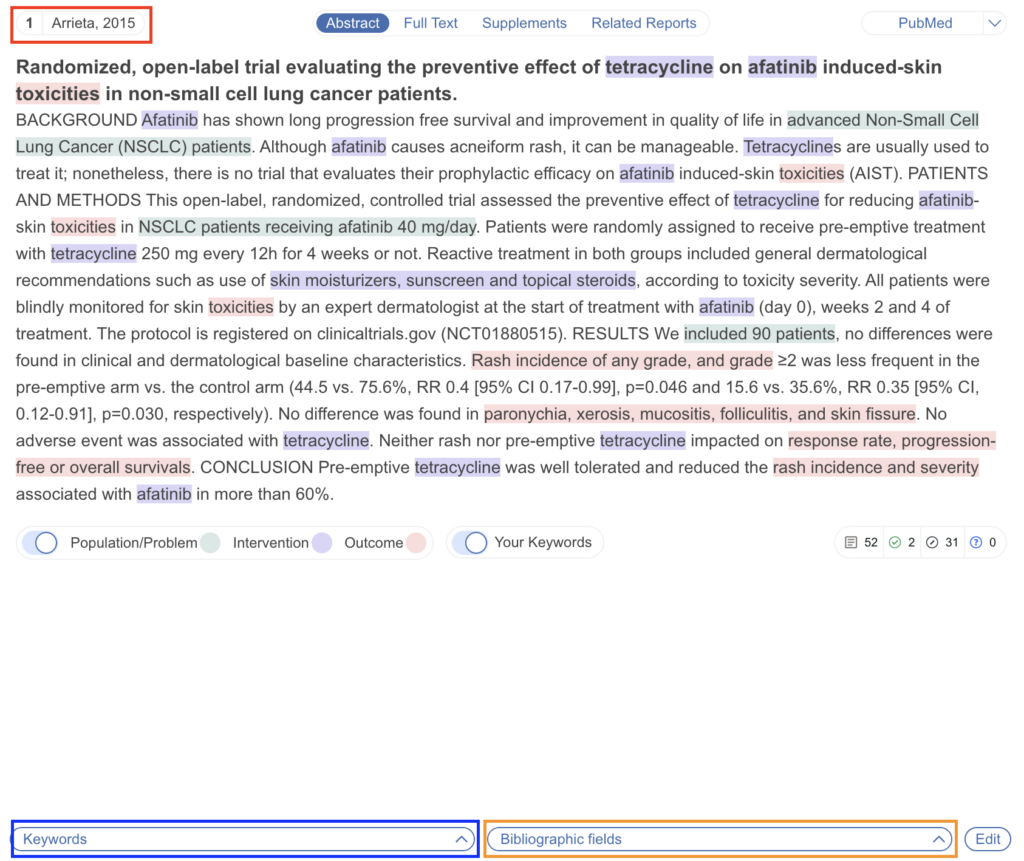
Navigation #
In the top right, you can access Background Jobs (three horizontal lines icon), the progress bar in Screening (below, 191/233 have been screened) and the Ask AI Chatbot for support.
The top left Navigation panel allows you to Skip a study, which adds the study to the back of the queue, or go Back to the previous study. Note: if you want to come back to a study but are struggling to find it in the Screening queue, use Study Inspector to add a filter and find your study to edit.

Retraction or Correction Notice #
If a study has been retracted or corrected, a banner is displayed on the record to alert you, providing the date and link to the full notice:
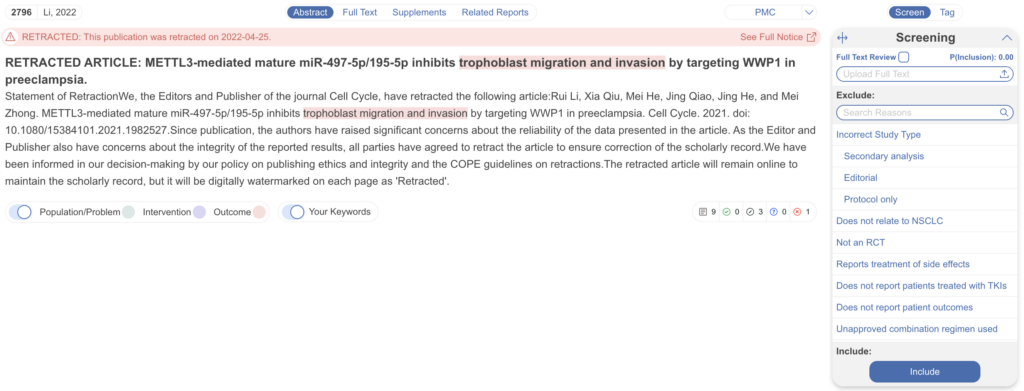
You may wish to be notified when studies you have included are retracted and/or correct, which can be toggled in Nest Settings. You can also find retracted and corrected articles by filtering to the “Publication Update” filter on Study Inspector.
3. Decide if study should be Included or Excluded #
If the abstract does not provide enough information for you to decide if it should be Included or Excluded, click on the study source button (in this case PubMed; blue) and source the full text of the study.
If you read the Full Text and decide it should be included, check the “Full Text Review” box.
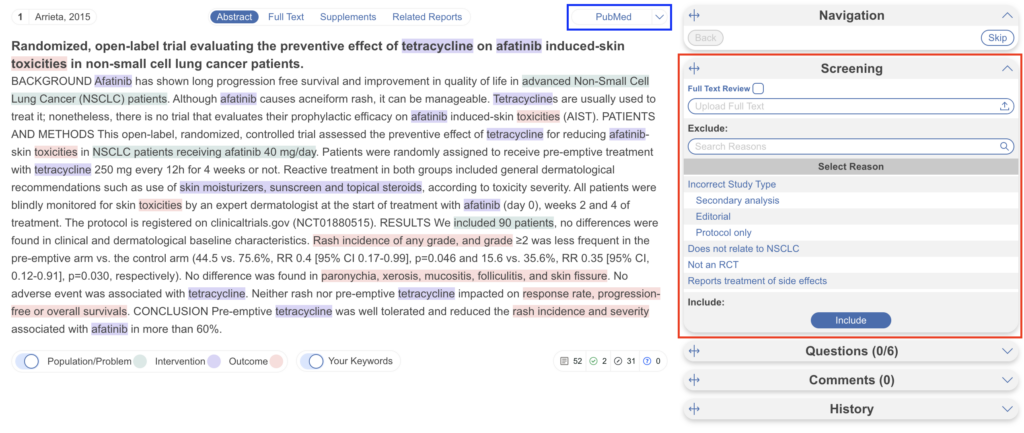
Exclude Records #
If you read the abstract and find that one or more of your Exclusion Reasons (red box above) are applicable, click on the reason that applies to that specific study. This will apply your reason and automatically bring up the next study to be screened.
Include Records #
If you read the abstract and find that none of your Exclusion Reasons apply, and that (based on information available to you) the publication in question is relevant to your review, select “Include” (see red box above).
Add Exclusion Reasons on the Fly #
You can add Exclusions Reasons as you screen without leaving the Screening page. To do so, in the Screening module, open the Exclusion Reason drop-down and begin typing in an Exclusion Reason.
If the reason of interest has not yet been configured, you can begin typing in the exclusion reason box and it will say “Add and Apply: Exclusion Reason”. Be careful as selecting this will apply it as a new exclusion reason and take you to the next study! If you wish to add an exclusion reason but not apply it, do so on the Configure Screening page.
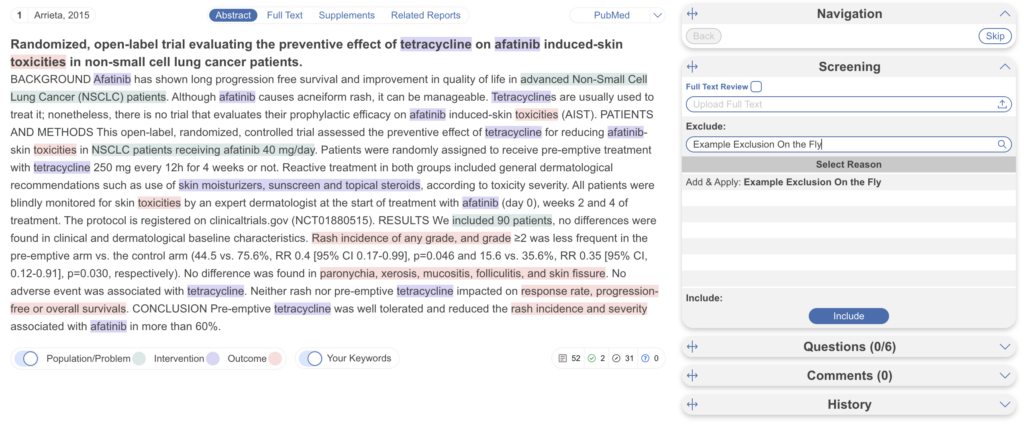
Unscreening a study #
If you have included or excluded a study that you want to revert to ‘unscreened’ status so that it can be reviewed again, you can either go “Back” in the Screening queue or unscreen it by finding the study of interest in Study Inspector.
Selecting the icon next to the Include button on the study you want to unscreen. A pop-up will appear and you can then click “Unscreen” to unscreen that single study.
Note: if you want to unscreen multiple studies, you can also do so using Bulk Actions!
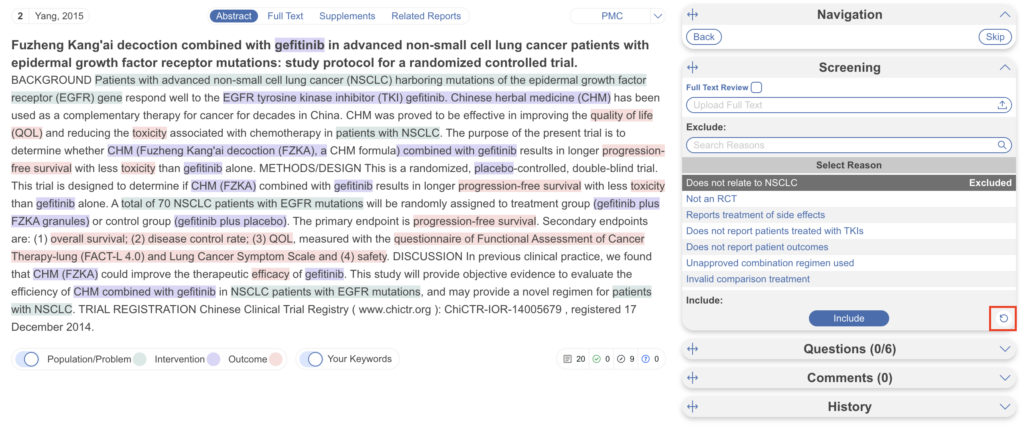
4. Upload the Full Text #
In general, uploading a Full Text should be completed only for Included records, and doing so assists in preparing the Tagging step.
For instructions on how to upload a Full Text PDF, click here.
No Full Text #
If you cannot source a full text for the study in question, you can assign a specific exclusion reason as signifying “No Full Text” within the PRISMA. For those records, first configure an Exclusion Reason as “No Full Text” (or equivalent) in the Configure Exclusion Reasons page.
Then select PRISMA Settings and select an exclusion reason to signify as No Full Text.
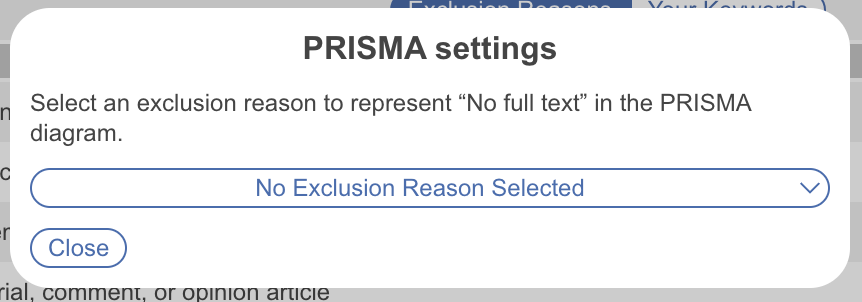
Implications: Marking “No Full Text” is a special PRISMA category, so the specific reason you configure for this purpose will be given its own listing in your PRISMA chart.
5. Upload Supplementary Materials #
If you want to upload supplementary files to a specific record, you can do so in the Supplements tab. To upload supplements, follow these instructions.
6. Mark Related Reports #
If you come across several studies as related to one another, you can mark it as a related report in the Related Reports tab. Then, the software will automatically adjust the PRISMA diagram to reflect this. To mark a paper as a related report, follow these instructions.
7. **Optional:** Applying Tags during Screening #
If you wish to apply preliminary tags in the Screening stage, you may do so. Learn how to configure tags via questions & answers, which can be applied at the preliminary stage.
Once configured, apply these tags during Screening using the Questions right-hand menu item:
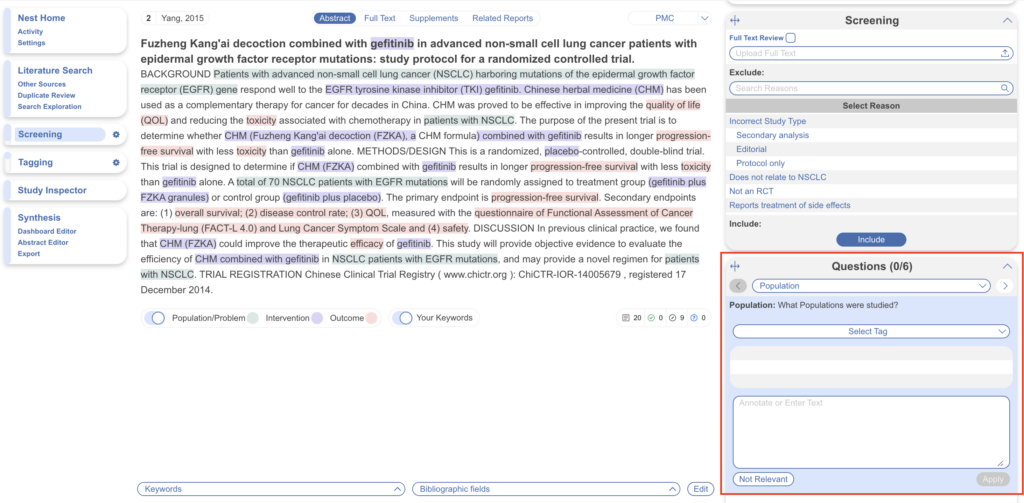
8. Continue Screening #
Once you have clicked “Include” or “Exclude” (or “skip”) for any study, you should be automatically shown the next study.
If you are screening from Inspector, you can use the arrows in the far left and right of the screen to navigate up or down, respectively, or click out to view the Inspector study list.
Duplicates #
If you find a study that was not automatically de-duplicated, click Related Reports, select Mark Duplicate, and then select the original study. Completing this action will remove the study from your screening queue and put it in the duplicate queue.
Learn more about Related Reports here.
Keyboard Shortcuts / Hot Keys #
If you prefer a quicker way of screening that doesn’t require cursor clicking on Advance/Include or an Exclusion Reason, you can switch on keyboard shortcuts. To do so, on any screening page (i.e. Screening modules or in Study Inspector Screening tabs), hit Ctrl + Shift + S and a modal will appear:

Toggle on Keyboard Shortcuts to use “a” for advance (Abstract Screening), “i” for include (Full Text Screening), and the first 9 exclusion reasons will be numbered for you to select the number corresponding to the reason. When Keyboard Shortcuts is on, these numbers will be displayed next to your exclusion reasons:
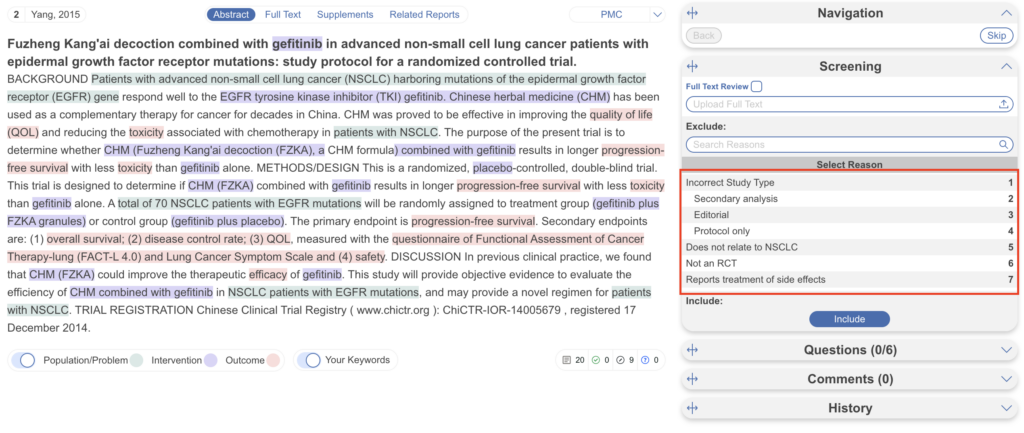
Keyboard shortcuts works for single, dual, standard and two-pass screening, including adjudication pages. To turn it off, simply hit Ctrl+Shift+S again and toggle it off. Turning shortcuts on and off is non-destructive.
